Get free scan and check if your device is infected.
Remove it nowTo use full-featured product, you have to purchase a license for Combo Cleaner. Seven days free trial available. Combo Cleaner is owned and operated by RCS LT, the parent company of PCRisk.com.
What is "Lloyds Bank Email Virus"?
Similar to "Deloitte Email Virus", "Payroll Timetable Email Virus", "Invoice Attached - FINAL NOTICE Email Virus", and many others, "Lloyds Bank Email Virus" is a spam email campaign used to distribute the TrickBot trojan.
Criminals send thousands of deceptive emails encouraging users to open malicious MS Office attachments. Once opened, however, these files immediately download and install TrickBot onto the system.
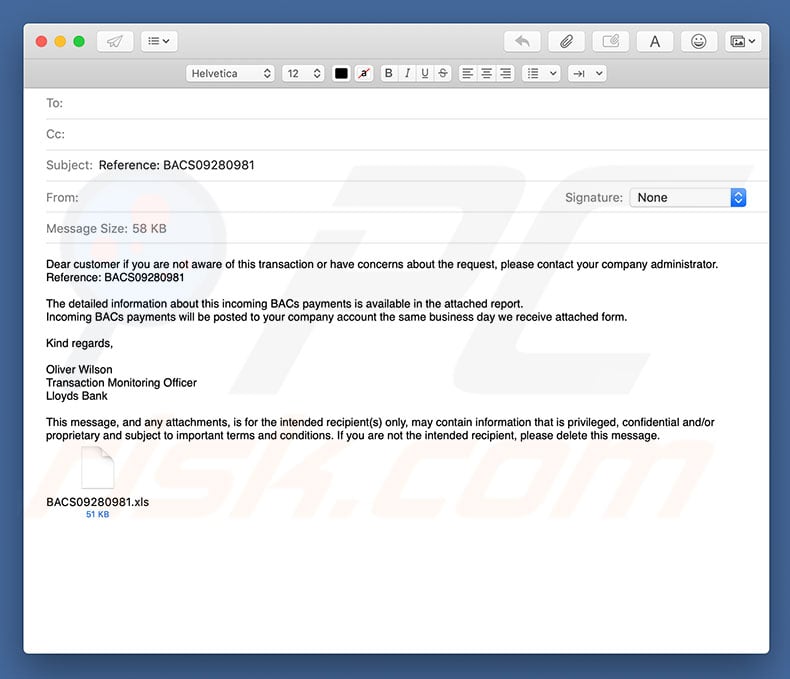
"Lloyds Bank Email Virus" messages are presented as notifications of a supposed transaction that has been made. It is stated that all detailed information regarding the payment is provided in the attached document and users are encouraged to open it. Opening the file results in system infection.
Note that the sender signs as an employee of Lloyds Bank, however, this is deceptive. Lloyds Bank is a legitimate bank and certainly not involved with this scam. Research shows that cyber criminals often hide behind names of popular companies and even governmental agencies.
They do this to increase the number of infections - users are much more likely to open attachments when they are received from familiar names. Be aware that TrickBot is a high-risk information-stealing trojan. It hijacks browsers and modifies visited website content, so that all entered logins/passwords are saved and sent to a remote server.
Cyber criminals might gain access to accounts for social networks, banks, PayPal, and so on. They aim to generate as much revenue as possible, and therefore hijacked accounts are misused through online purchases, money transfers, etc. The presence of a virus such as TrickBot might lead to serious privacy issues or even identity theft.
If you have already opened a "Lloyds Bank Email Virus" campaign attachment, immediately scan the system with a reputable anti-virus/anti-spyware suite and eliminate all detected threats.
| Name | Lloyds Bank spam |
| Threat Type | Trojan, Password stealing virus, Banking malware, Spyware |
| Symptoms | Trojans are designed to stealthily infiltrate victim's computer and remain silent thus no particular symptoms are clearly visible on an infected machine. |
| Distribution methods | Infected email attachments, malicious online advertisements, social engineering, software cracks. |
| Damage | Stolen banking information, passwords, identity theft, victim's computer added to a botnet. |
| Malware Removal (Windows) |
To eliminate possible malware infections, scan your computer with legitimate antivirus software. Our security researchers recommend using Combo Cleaner. Download Combo CleanerTo use full-featured product, you have to purchase a license for Combo Cleaner. 7 days free trial available. Combo Cleaner is owned and operated by RCS LT, the parent company of PCRisk.com. |
There are dozens of trojan-type viruses distributed using spam campaigns, all of which are similar to TrickBot. The list of examples includes (but is not limited to) Emotet, Ursnif, Adwind, and Hancitor.
These viruses have different developers and their behavior might also differ (some gather information, whilst others proliferate other viruses, and so on), however, all pose a direct threat to your privacy and computer safety. Therefore, eliminate trojans such as TrickBot immediately.
How did "Lloyds Bank Email Virus" infect my computer?
As mentioned above, "Lloyds Bank Email Virus" distributes a malicious MS Office document. Once opened, the file immediately asks users to enable macro commands, otherwise the content will not be displayed properly, however, in doing so, users enable attachments to download and install TrickBot onto the system.
This malware distribution method is simple and effective, but has a major flaw. Attachments can only download viruses if they are opened using MS Office's programs.
For example, if a Word file is opened using an application other than MS Word, the computer will not be infected. Furthermore, TrickBot works only on the Microsoft Operating system. Users of other platforms have nothing to worry about.
How to avoid installation of malware?
Be cautious when browsing the Internet. Think twice before opening email attachments. If the file is irrelevant/unexpected or the sender seems suspicious/unrecognizable, you should never open it. Furthermore, have a reputable anti-virus/anti-spyware suite installed and running, since these tools can detect and eliminate malicious files before they do any damage.
The main reasons for computer infections are poor knowledge and careless behavior - the key to safety is caution. If you have already opened "Lloyds Bank Email Virus" attachment, we recommend running a scan with Combo Cleaner Antivirus for Windows to automatically eliminate infiltrated malware.
Text presented in the "Lloyds Bank Email Virus" email message:
Subject: Reference: BACS09280981
Dear customer if you are not aware of this transaction or have concerns about the request, please contact your company administrator.
Reference: BACS09280981
The detailed information about this incoming BACs payments is available in the attached report.
Incoming BACs payments will be posted to your company account the same business day we receive attached form.
Kind regards,
Oliver Wilson
Transaction Monitoring Officer
Lloyds Bank
This message, and any attachments, is for the intended recipient(s) only, may contain information that is privileged, confidential and/or proprietary and subject to important terms and conditions. If you are not the intended recipient, please delete this message.
Malicious attachment distributed via "Lloyds Bank Email Virus" spam campaign:
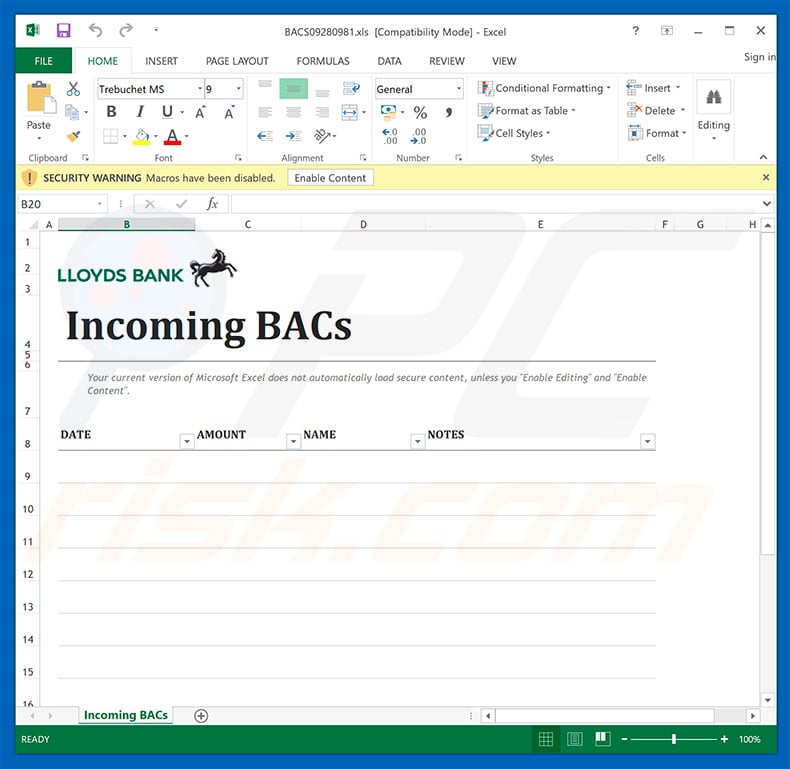
Second variant of "Lloyds Bank Email Virus" that also distributes TrickBot:
Screenshot of deceptive email:
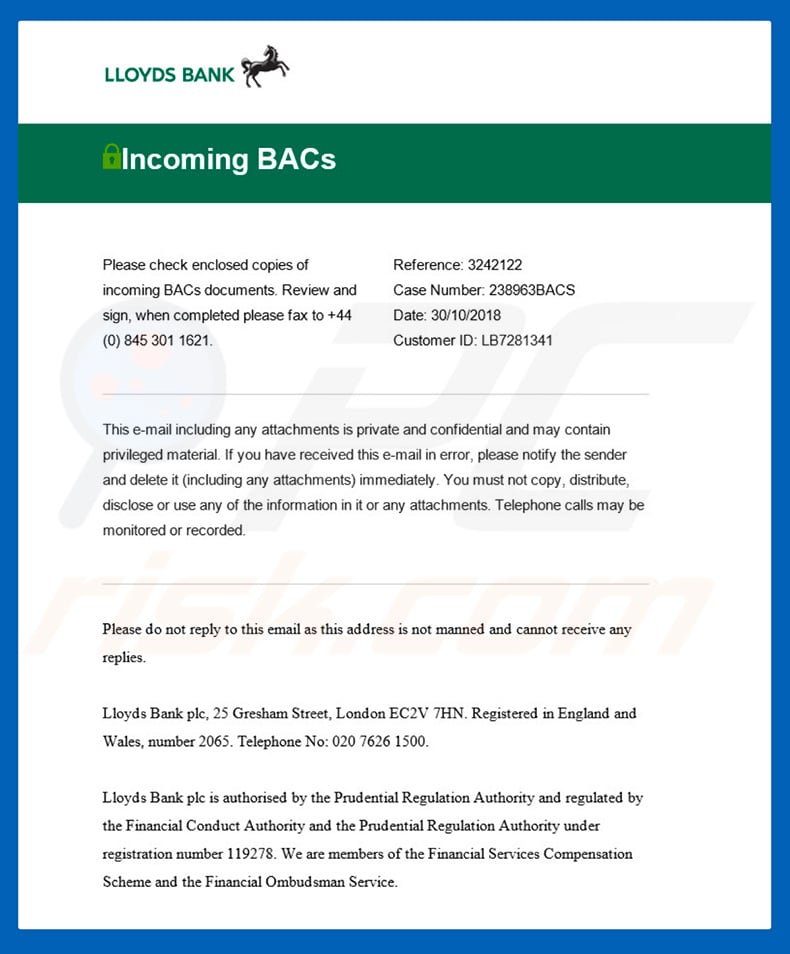
Text presented within this email:
Subject: Case Number: 238963BACS
This secure email was sent to: m.riefenstahl@myonlinesecurity.co.uk
Incoming BACs
Please check enclosed copies of incoming BACs documents. Review and sign, when completed please fax to +44 (0) 845 301 1621.
Reference: 3242122
Case Number: 238963BACS
Date: 30/10/2018
Customer ID: LB7281341
This e-mail including any attachments is private and confidential and may contain privileged material. If you have received this e-mail in error, please notify the sender and delete it (including any attachments) immediately. You must not copy, distribute, disclose or use any of the information in it or any attachments. Telephone calls may be monitored or recorded.
Please do not reply to this email as this address is not manned and cannot receive any replies.
Lloyds Bank plc, 25 Gresham Street, London EC2V 7HN. Registered in England and Wales, number 2065. Telephone No: 020 7626 1500.
Lloyds Bank plc is authorised by the Prudential Regulation Authority and regulated by the Financial Conduct Authority and the Prudential Regulation Authority under registration number 119278. We are members of the Financial Services Compensation Scheme and the Financial Ombudsman Service.
Screenshot of malicious attachment:
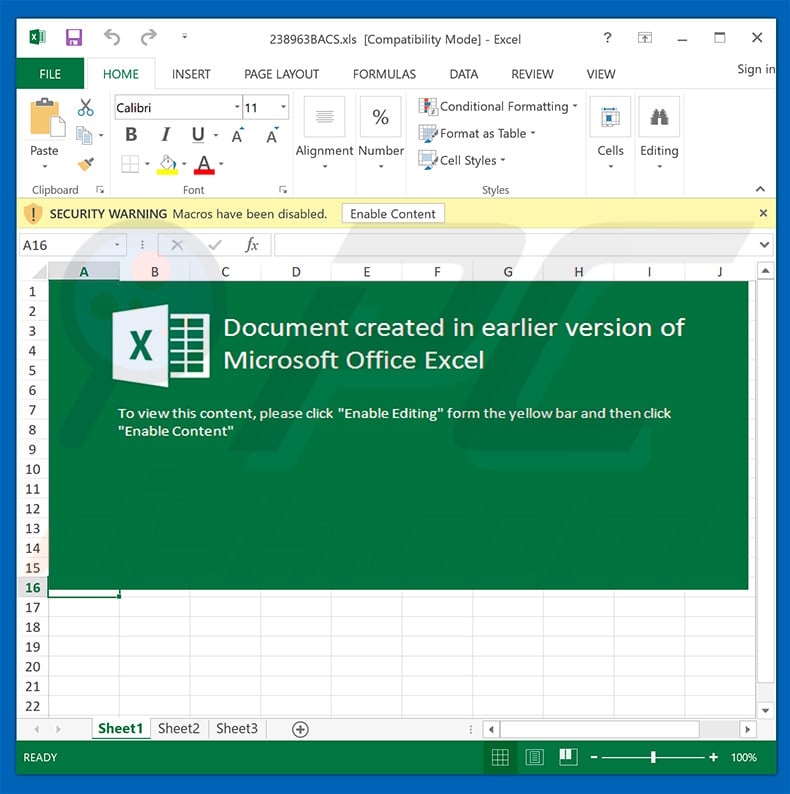
Third variant of "Lloyds Bank Email Virus":
Screenshot of the email:
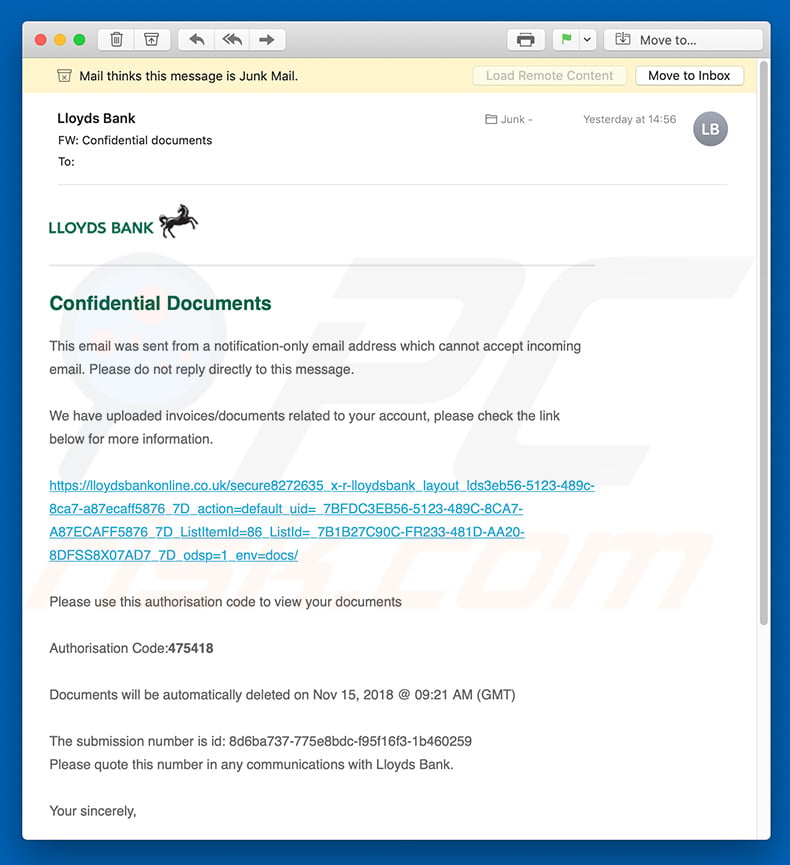
Text presented within this email:
Lloyds Bank
Confidential Documents
This email was sent from a notification-only email address which cannot accept incoming email. Please do not reply directly to this message.We have uploaded invoices/documents related to your account, please check the link below for more information.
Please use this authorisation code to view your documents
Authorisation Code:475418
Documents will be automatically deleted on Nov 15, 2018 @ 09:21 AM (GMT)
The submission number is id: 8d6ba737-775e8bdc-f95f16f3-1b460259
Please quote this number in any communications with Lloyds Bank.
Your sincerely,Robina Barker Bennett
Senior Officer
Lloyds BankCalls may be monitored or recorded in case we need to check we have carried out your instructions correctly and to help improve our quality of service.
Disclaimer: This email and any attachments are confidential and for the sole use of the recipients. If you have received this email in error please notify the sender.Email Security Powered by Lloyds Bank Online. Copyright 2002-2018 Lloyds Bank Security, PLC. All rights reserved.
Update 7 December, 2018 - Cyber criminals released a new variant of "Lloyds Bank Email Virus" spam campaign which now proliferates Ursnif. The malicious attachment is PDF document which, once opened, downloads a VBS file from Google Docs. This VBS file then downloads the actual malware and infects the system.
Screenshot of the email letter:
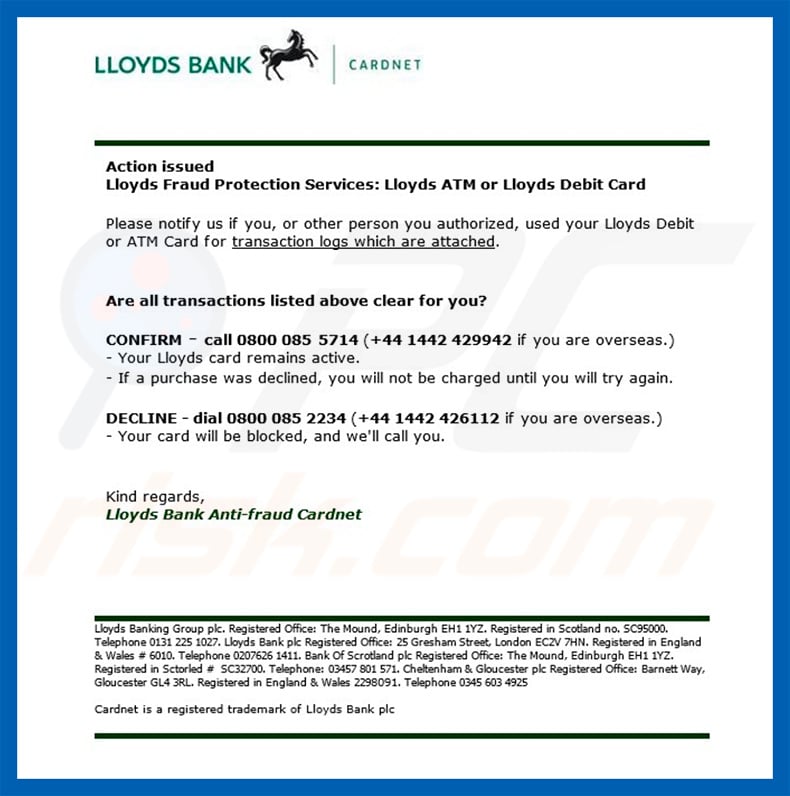
Text presented within this letter:
Subject: Lloyds Fraud Protection Services
Action issued
Lloyds Fraud Protection Services: Lloyds ATM or Lloyds Debit CardPlease notify us if you, or other person you authorized, used your Lloyds Debit or ATM Card for transaction logs which are attached.
Are all transactions listed above clear for you?
CONFIRM – call 0800 085 5714 (+44 1442 429942 if you are overseas.)
– Your Lloyds card remains active.
– If a purchase was declined, you will not be charged until you will try again.DECLINE – dial 0800 085 2234 (+44 1442 426112 if you are overseas.)
– Your card will be blocked, and we’ll call you.Kind regards,
Lloyds Bank Anti-fraud CardnetLloyds Banking Group plc. Registered Office: The Mound, Edinburgh EH1 1YZ. Registered in Scotland no. SC95000. Telephone 0131 225 1027. Lloyds Bank plc Registered Office: 25 Gresham Street, London EC2V 7HN. Registered in England & Wales # 6010. Telephone 0207626 1411. Bank Of Scrotland plc Registered Office: The Mound, Edinburgh EH1 1YZ. Registered in Sctorled # SC32700. Telephone: 03457 801 571. Cheltenham & Gloucester plc Registered Office: Barnett Way, Gloucester GL4 3RL. Registered in England & Wales 2298091. Telephone 0345 603 4925
Cardnet is a registered trademark of Lloyds Bank plc
Screenshot of malicious attachment (PDF file):
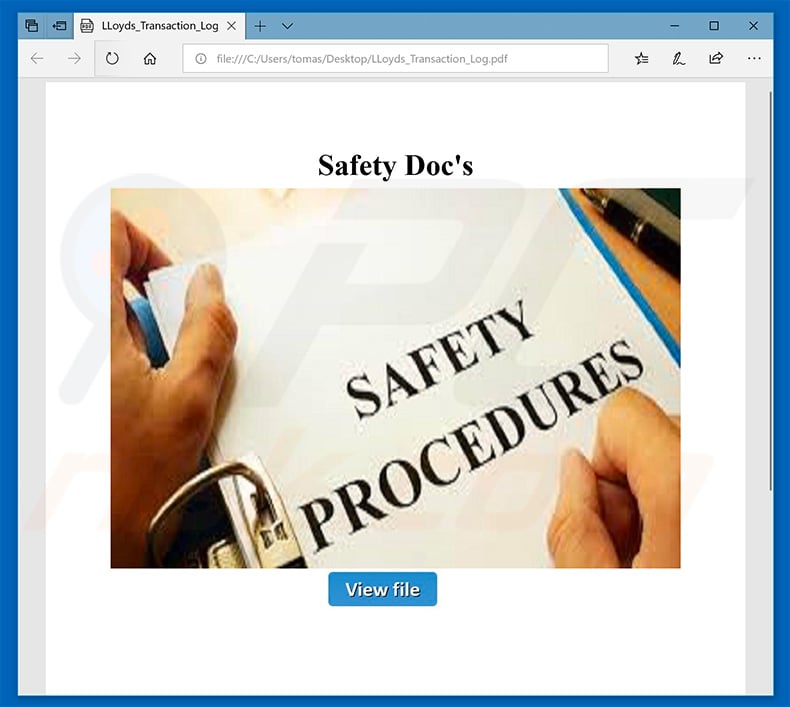
Instant automatic malware removal:
Manual threat removal might be a lengthy and complicated process that requires advanced IT skills. Combo Cleaner is a professional automatic malware removal tool that is recommended to get rid of malware. Download it by clicking the button below:
DOWNLOAD Combo CleanerBy downloading any software listed on this website you agree to our Privacy Policy and Terms of Use. To use full-featured product, you have to purchase a license for Combo Cleaner. 7 days free trial available. Combo Cleaner is owned and operated by RCS LT, the parent company of PCRisk.com.
Quick menu:
- What is Lloyds Bank spam?
- Types of malicious emails.
- How to spot a malicious email?
- What to do if you fell for an email scam?
Types of malicious emails:
![]() Phishing Emails
Phishing Emails
Most commonly, cybercriminals use deceptive emails to trick Internet users into giving away their sensitive private information, for example, login information for various online services, email accounts, or online banking information.
Such attacks are called phishing. In a phishing attack, cybercriminals usually send an email message with some popular service logo (for example, Microsoft, DHL, Amazon, Netflix), create urgency (wrong shipping address, expired password, etc.), and place a link which they hope their potential victims will click on.
After clicking the link presented in such email message, victims are redirected to a fake website that looks identical or extremely similar to the original one. Victims are then asked to enter their password, credit card details, or some other information that gets stolen by cybercriminals.
![]() Emails with Malicious Attachments
Emails with Malicious Attachments
Another popular attack vector is email spam with malicious attachments that infect users' computers with malware. Malicious attachments usually carry trojans that are capable of stealing passwords, banking information, and other sensitive information.
In such attacks, cybercriminals' main goal is to trick their potential victims into opening an infected email attachment. To achieve this goal, email messages usually talk about recently received invoices, faxes, or voice messages.
If a potential victim falls for the lure and opens the attachment, their computers get infected, and cybercriminals can collect a lot of sensitive information.
While it's a more complicated method to steal personal information (spam filters and antivirus programs usually detect such attempts), if successful, cybercriminals can get a much wider array of data and can collect information for a long period of time.
![]() Sextortion Emails
Sextortion Emails
This is a type of phishing. In this case, users receive an email claiming that a cybercriminal could access the webcam of the potential victim and has a video recording of one's masturbation.
To get rid of the video, victims are asked to pay a ransom (usually using Bitcoin or another cryptocurrency). Nevertheless, all of these claims are false - users who receive such emails should ignore and delete them.
How to spot a malicious email?
While cyber criminals try to make their lure emails look trustworthy, here are some things that you should look for when trying to spot a phishing email:
- Check the sender's ("from") email address: Hover your mouse over the "from" address and check if it's legitimate. For example, if you received an email from Microsoft, be sure to check if the email address is @microsoft.com and not something suspicious like @m1crosoft.com, @microsfot.com, @account-security-noreply.com, etc.
- Check for generic greetings: If the greeting in the email is "Dear user", "Dear @youremail.com", "Dear valued customer", this should raise suspiciousness. Most commonly, companies call you by your name. Lack of this information could signal a phishing attempt.
- Check the links in the email: Hover your mouse over the link presented in the email, if the link that appears seems suspicious, don't click it. For example, if you received an email from Microsoft and the link in the email shows that it will go to firebasestorage.googleapis.com/v0... you shouldn't trust it. It's best not to click any links in the emails but to visit the company website that sent you the email in the first place.
- Don't blindly trust email attachments: Most commonly, legitimate companies will ask you to log in to their website and to view any documents there; if you received an email with an attachment, it's a good idea to scan it with an antivirus application. Infected email attachments are a common attack vector used by cybercriminals.
To minimise the risk of opening phishing and malicious emails we recommend using Combo Cleaner Antivirus for Windows.
Example of a spam email:

What to do if you fell for an email scam?
- If you clicked on a link in a phishing email and entered your password - be sure to change your password as soon as possible. Usually, cybercriminals collect stolen credentials and then sell them to other groups that use them for malicious purposes. If you change your password in a timely manner, there's a chance that criminals won't have enough time to do any damage.
- If you entered your credit card information - contact your bank as soon as possible and explain the situation. There's a good chance that you will need to cancel your compromised credit card and get a new one.
- If you see any signs of identity theft - you should immediately contact the Federal Trade Commission. This institution will collect information about your situation and create a personal recovery plan.
- If you opened a malicious attachment - your computer is probably infected, you should scan it with a reputable antivirus application. For this purpose, we recommend using Combo Cleaner Antivirus for Windows.
- Help other Internet users - report phishing emails to Anti-Phishing Working Group, FBI’s Internet Crime Complaint Center, National Fraud Information Center and U.S. Department of Justice.
Share:

Tomas Meskauskas
Expert security researcher, professional malware analyst
I am passionate about computer security and technology. I have an experience of over 10 years working in various companies related to computer technical issue solving and Internet security. I have been working as an author and editor for pcrisk.com since 2010. Follow me on Twitter and LinkedIn to stay informed about the latest online security threats.
PCrisk security portal is brought by a company RCS LT.
Joined forces of security researchers help educate computer users about the latest online security threats. More information about the company RCS LT.
Our malware removal guides are free. However, if you want to support us you can send us a donation.
DonatePCrisk security portal is brought by a company RCS LT.
Joined forces of security researchers help educate computer users about the latest online security threats. More information about the company RCS LT.
Our malware removal guides are free. However, if you want to support us you can send us a donation.
Donate
▼ Show Discussion